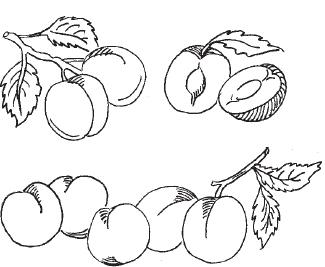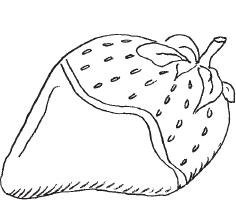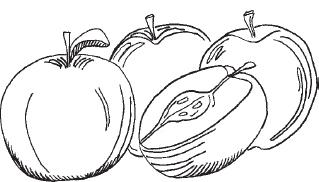Nourishing Traditions: The Cookbook That Challenges Politically Correct Nutrition and The... (148 page)
Authors: Sally Fallon,Pat Connolly,Phd. Mary G. Enig
Tags: #Non-Fiction, #Reference, #Science, #Health

APRICOT COMPOTE
Serves 6-8
3 cups dried unsulphured apricots
½ cup maple syrup
1 cup water
¼ teaspoon sea salt
2 cups
piima cream
or
creme fraiche½ cup crispy almond slivers (
Crispy Almonds
), toasted
Place apricots, maple syrup, water and salt in a sauce pan. Simmer, uncovered, for about 1 hour or until soft and most of liquid is absorbed or evaporated. Process in food processor until smooth and let cool. Fold piima cream into the apricot mixture and place in a serving dish, individual bowls or parfait glasses. Top with almonds. Serve well chilled.
The desire for sweet is inborn and instinctual. Research reveals that as increasing amounts of sugar are added to a newborn's bottle, the rate of sucking increases. Small children offered a choice between a healthy food and a heavily sweetened one will overwhelmingly choose the sweet. Our first food, mother's milk, is naturally sweet; and some say it is very sweet when considering the highly sensitive taste buds of an infant. From an evolutionary standpoint, our preference for sweets is highly advantageous for survival. Not only did it direct early hominids toward easily available ripe fruits and vegetables, it kept them away from poisonous plants, which are usually bitter in taste. No sweet foods are known to exist in nature that are poisonous. But the longing for sweets goes far beyond biology. It goes beyond the pleasure of taste and beyond the instincts of the body. Marc David
Nourishing Wisdom

STEWED RHUBARB
Serves 6
6 cups fresh rhubarb, cut into 1-inch pieces
1 tablespoon freshly ground ginger
about ½ cup filtered water
½-¾ cups raw honey
Place rhubarb, ginger and water in a pan and bring to a boil. Reduce heat to a simmer and cook about 1 hour, stirring occasionally, until rhubarb disintegrates. Allow to cool and stir in honey to taste. Serve with whipped cream or
sweet cheese topping
.
AMBROSIA
Serves 6-8
8 navel oranges
1 cup unsweetened date pieces
¾ cup
dried sweetened coconut meat1 cup
crispy pecans
, chopped
Peel and slice oranges. Place in a serving bowl and sprinkle on date pieces, coconut and pecans. Serve well chilled.
Refined white sugar carries only negligible traces of bodybuilding and repairing material. It satisfies hunger by providing heat and energy besides having a pleasant flavor. The heat and energy producing factors in our food that are not burned up are usually stored as fat. . .we have seen that approximately half of the foods provided in our modern dietaries furnish little or no bodybuilding or repairing material and supply no vitamins. Approximately 25 percent of the heat and energy of the American people is supplied by sugar alone, which goes far in thwarting nature's orderly processes of life. Weston Price, DDS
Nutrition and Physical Degeneration
CAROB DIPPED STRAWBERRIES
Serves 8
24 large strawberries with stems
2½ cups
carob sauce
Wash strawberries and drain on paper towels. Dip each strawberry in carob sauce and place on waxed paper. Chill well before serving.

FRIED BANANAS
Serves 8
8 very ripe large plantain bananas 16 small red bananas
about ½ cup extra virgin olive oil or lard
1 cup fresh orange juice
1
/
3
cup honey1 teaspoon cinnamon
piima cream
or
creme fraiche
for garnish
Peel bananas and cut lengthwise. Saute in batches in olive oil or lard, transferring with a slotted spoon to an oblong pyrex dish. Make a mixture of orange juice, honey and cinnamon. Pour over the bananas and bake at 300 degrees for about 15 minutes. Serve in bowls with a dollop of cultured cream.
Yudkin analyzed the sugar consumption habits of men with atherosclerosis. . .the men who had heart attacks reported a sugar intake nearly twice as high as those not having the heart attacks; and, moreover, in patients with artery disease the degree of atherosclerosis was proportional to the amount of sugar consumed. . .. The statistical figures indicate the relationship between sugar consumption and heart attack and between sugar consumption and artery disease was extremely strong in this study. Chris Mudd
Cholesterol and Your Health
SAUTEED APPLES
Serves 4
6 apples, peeled and cut into chunks
4 tablespoons butter
In a heavy skillet, saute the apples in butter until golden. Serve with
whipped cream
.
Variation: Sauteed Asian Pears
Use
6 Asian pears, peeled and cut into chunks
, instead of apples. This is a delicious accompaniment to game!
In the spiritual tradition of India, it is said that if you could taste the soul, it would be sweet. Indeed, the human condition in some of its most precious moments is perceived as "sweet": "the sweet life," our "sweetheart," "sweet dreams," or "the sweet smell of success." Sweetness is an
experience
, and food is just one doorway that leads us there.
The Sufis believe that every object and sensation on the physical plane has a corresponding mirror image on higher planes. In their view the sweetness of food (on the physical level) is reflected in the sweetness of love (emotional), which is reflected in the sweetness of divine ecstasy (spiritual). Even though the sweetness of a chocolate truffle differs radically from the sweetness shared between lovers, the metaphoric connections still exist.
In fact, scientists have recently discovered a chemical compound in chocolate—phenylethylamine—believed to mimic the physiological sensations of love. Even more fascinating, in the religious traditions of the Hindus, Taoists, and Tibetan Buddhists, mystics have referred to an ecstatic state where a sensation of indescribable sweetness spontaneously arises in the mouth. Contemporary accounts of this phenomenon are widespread among meditators and practitioners of religious traditions of the East and the West. Furthermore, the Austrian philosopher-scientist Rudolf Steiner pointed out the role various foods have played in the evolution of consciousness in different historical epochs. Sugar is seen as a food that has had a powerful effect in helping to expand personality force, creativity, and self-consciousness. Even today historians are at a loss to understand why so many wars have been fought over sugar and different spices. I offer this reason: Sugar and spices were the drugs of earlier cultures. When these foods were first introduced, their effect was even more powerfully narcotic and mind expanding than they are today.
When we eat sweets, our desire is not just for food. Our longing is for the
experience
of
sweetness
, something we can taste on the tongue, in the heart, or in our most sacred thoughts. However, because it is more difficult to find a sweetheart or sweet Jesus, the mind often considers sweet foods an acceptable substitute. Food happens to be the most available form of the sweet experience. Can you see how we instinctively crave sweetness on several different levels? Do you understand why it is a perfectly natural biological phenomenon?
Sugary food is one of the most popular forms of substitute love. Its effect is even more potent when combined with the love-inducing chemicals in chocolate. The downside of repeated substitution is the same for sugar as it is for drugs, alcohol, or cigarettes—dependency. We become mechanically bound to sugar because it fulfills an immediate need and exerts a powerful narcotic effect.
It is important to note that the need for the sweet experience is inborn; but as every nutritional scientist knows, there is no physiological requirement for refined sugar in the diet. Quite the contrary. Excess sugar in the diet promotes tooth decay and obesity and has been implicated in heart disease, diabetes, hypoglycemia, immune deficiency diseases, digestive disorders, and allergies. Perhaps the most fascinating and best kept medical secret about sugar is that excessive consumption causes calcium loss, which leads to a much publicized disease of our day—osteoporosis. Marc David
Nourishing Wisdom

ARISTOCRATIC APPLES
Serves 4
4 large tart apples
juice of 1 lemon
1 cup water
½ cup raisins, soaked in warm water
¼ teaspoon saffron threads dissolved in 1 tablespoon water
4 tablespoons butter
½ cup
piima cream
or
creme fraiche3 tablespoons maple syrup
½ cup crispy almond slivers (
Crispy Almonds
), toasted¼ teaspoon ground cardamom
